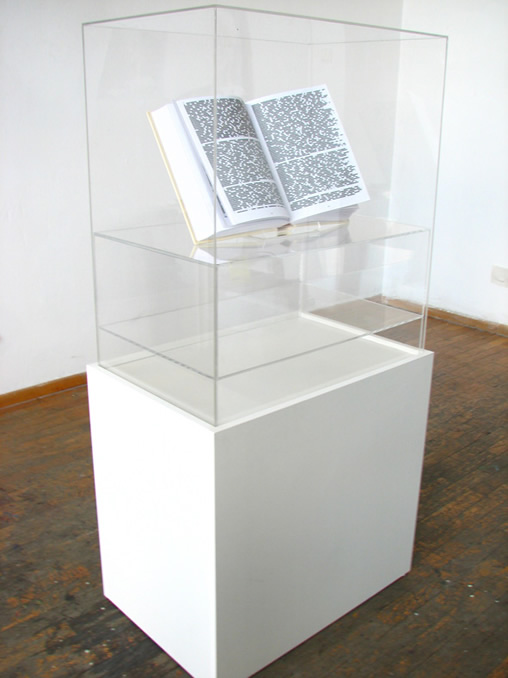The Bible
Tanja JURIČAN

Artistic-semiotic reinterpretation of the canonic text of the Bible.
The work is made up of an object ÔÇô the book placed in a closed pedestal made of wood and clirite. The intervention is percieved in the transformation from the textual to the visual, by dealpahbetising the alphabet. The graphemes have been replaced by the photographs of phonemic pronunciation. The written signs of the alphabet have been abolished as symbolic and graphic equivalents of phonemes. The succession of phono-labial pictures (reminding of the raster, matrix or a binary scheme) creates an illusion of lip movements and visually active speech. Making the text mobile has given it a visual ÔÇŞvoiceÔÇØ and made it formally come to life by taking an active attitude towards the reader. The act of reading such a ┬áÔÇŞtextÔÇØ requires a willingness on behalf of the reader to be dedicated to the activity of reading.
The work functions as an invitation to return to the deep and suppressed layers of presentation and meaning and problematises the structure and the mechanisms of functioning of the linguistic code, its possible discourse, reception and interpretation. We should not lose sight of the accent put on the element of creatorÔÇÖs potential of speech. The Biblical God creates the universe by using the exact language logos, so one could say that through this work the canonic text of the Bible has been symbolically restored to its origin. I would also like to stress its reference to the pictograph, cuneiform or ideographic alphabets of the ancient civilisations in pre-phonetic stages together with the fact that in this representation even the illiterate can read the Bible.
In this way the canonic text has been provokingly deformed by a successful inlaying and penetrating of the feminine and individual into the domain of the partiarchal and general, thereby dethroning the canon and at the same time making it deeply individual.
The white leather covers underline earthly existence by suggesting ÔÇŞpurificationÔÇØ of religious associations and divisions created by religious and political interpretations in connection with ÔÇŞthe holyÔÇØ text.
|||||||||||||||||||||||||||||||||||||||||||||||||||||||||||||||||||||||||||||||||||||||||||||||||||||||||||||||||||||||||||||||||||||||||||||||||||||||||||||||||||||
Tanja Juri─ıan was born in 1980 in Pan─ıevo. In 2009 she graduated Painting at the Faculty of Arts in Belgrade.
Contact: tanjajurican(at)yahoo.com